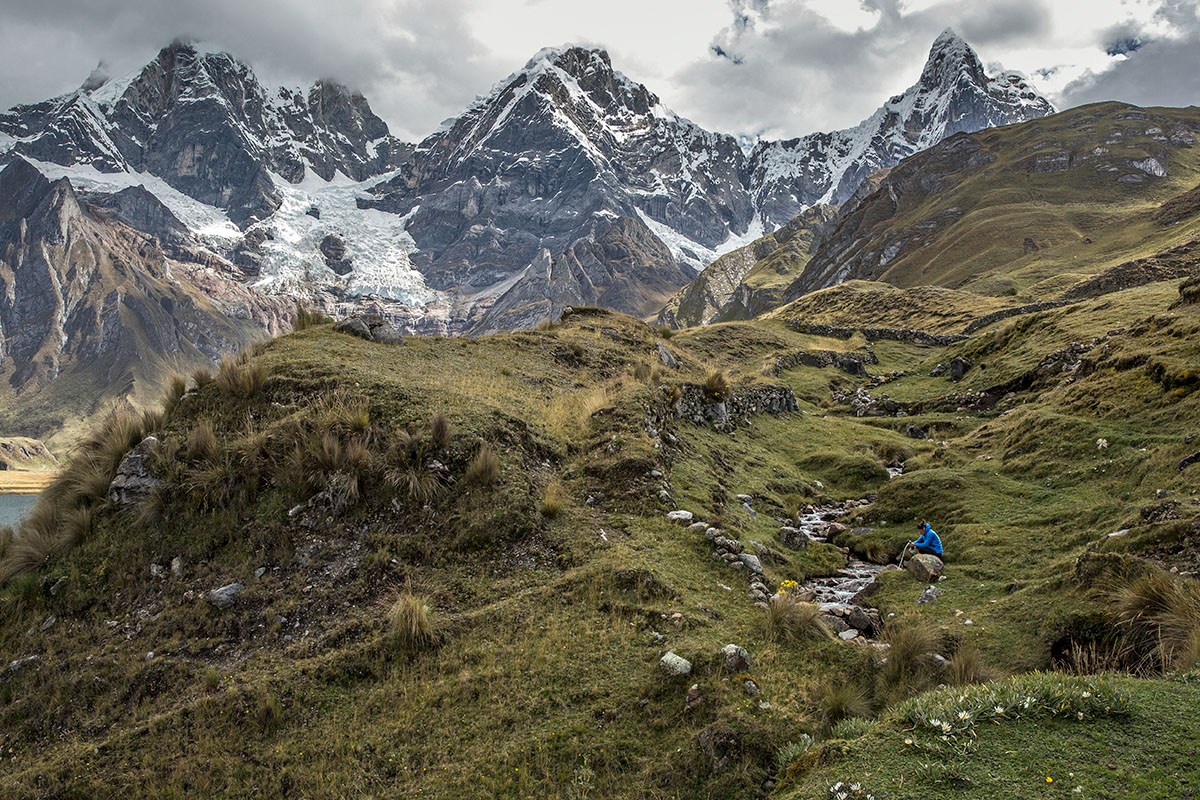
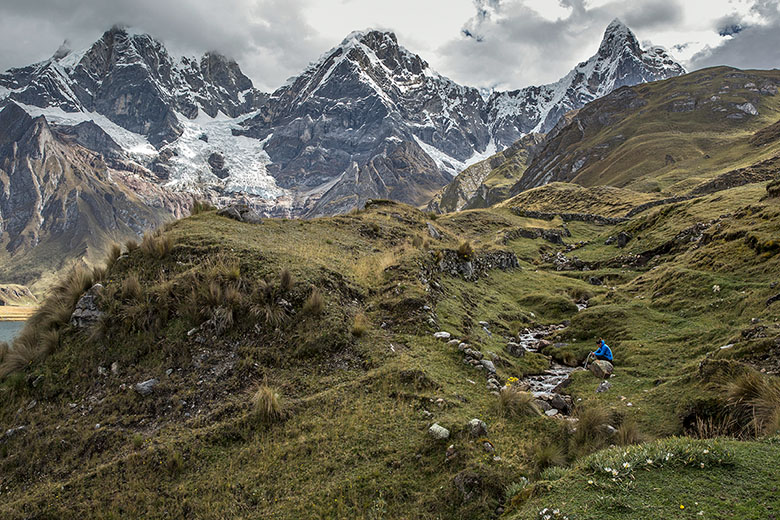
Staying hydrated is an absolute necessity on any outdoor excursion, but if you’re headed out for more than a few hours, it might be unrealistic to carry all the water you need. While streams, lakes, and ponds along the trail can be great drinking sources, it’s prudent to treat any water you ingest. The good news is there are plenty of lightweight, affordable water filters and purifiers built with backcountry travelers in mind. Below we break down everything you need to know before buying a backpacking water filter or purifier, including the different styles available, weight and packability, flow rate, filter life, and more. And for a look at our top picks, see our article on the best backpacking water filters and purifiers.
The terms “water filter” and “water purifier” are often used interchangeably, but there’s a key difference between the two: while filters remove protozoa and bacteria from the water, purifiers protect add virus protection to the mix. Water filters feature cartridges with tiny pores that physically filter out the protozoa and bacteria, while purifiers combat harmful agents through chemical treatment, UV exposure, or microscopic fibers. The downside to water purifiers is that they generally do not filter out sediment, so while the water may be safe to drink, it might still be contaminated with small particles. One exception is the MSR Guardian Purifier, a setup that both filters and purifies for the highest levels of drinkability and protection.
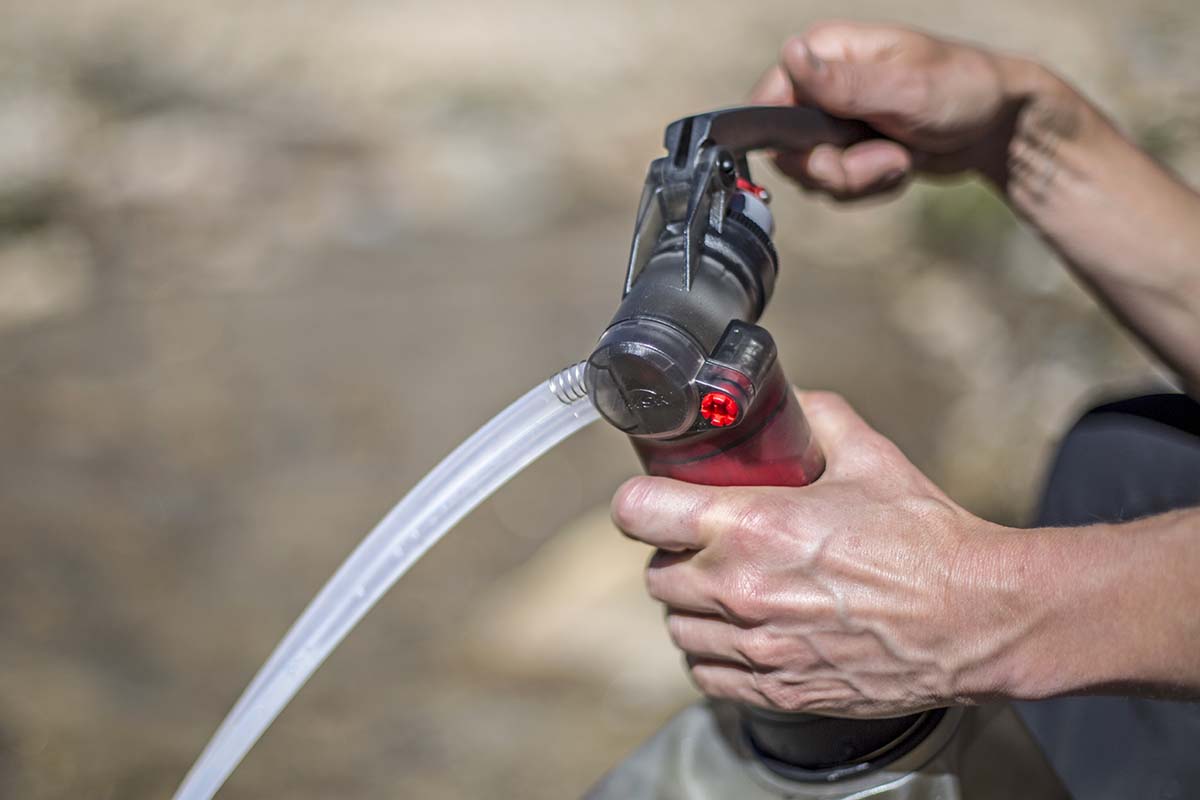
For most backcountry areas in the United States and Canada, the general consensus is that you can get away with just a water filter. For international travel in less-developed nations (not limited to backcountry use), we recommend the virus protection of a water purifier. And here’s our reasoning: viruses are most often transported by human waste, which is not often found contaminating water sources in wilderness areas. However, given increased traffic in the outdoors and poor observance of Leave No Trace, there are no assurances. Although the likelihood is fairly low that you’ll contract a virus from a backcountry water source, many cautious adventurers will opt for the protection of a purifier.
There are multiple styles of backpacking water filters and purifiers, and each has its advantages and disadvantages, with key differences between weight, speed, convenience, and more. Below we break down gravity filters, pump filters or purifiers, bottle filters or purifiers, straw filters, chemical purifiers, and UV purifiers.
Gravity filters tend to be the fastest and most convenient way to get clean water in the backcountry. They work by filling up a “dirty” water reservoir from the water source and hanging it from a branch (or whatever is available). Gravity does the work by pulling the water down through the filter and into a clean receptacle. These models, like the Platypus GravityWorks 4L, are great for camping with groups or for use in your camp kitchen, as they filter large amounts of water relatively quickly. It’s also a big plus that you can simply hang up the bag and let gravity do the work, unlike other methods that can be more arduous and time-consuming.
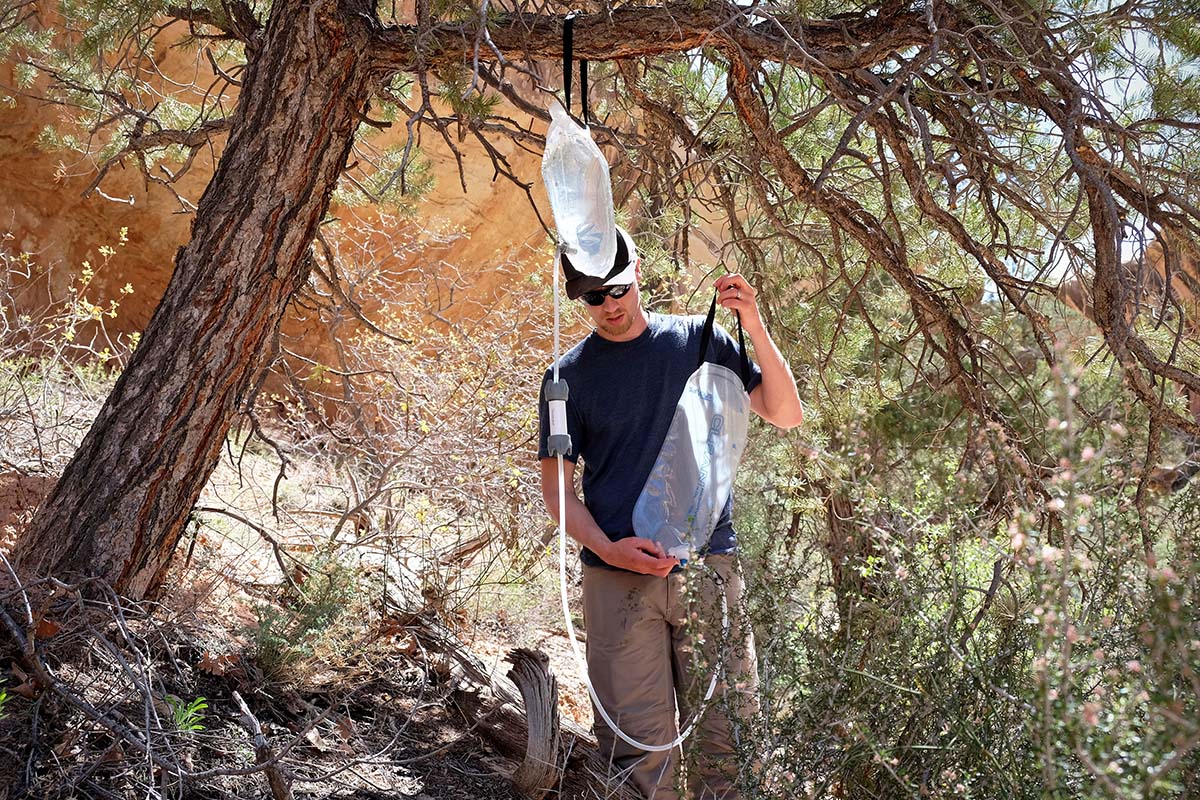
The main downside to gravity filters is that they are bulkier and heavier than alternatives like bottle or straw filters. Further, they are a bit awkward to pack, consisting of at least one (and many times two) reservoirs, a hose, and a filter. It can also be challenging to fill up the dirty water reservoir if your water source isn’t deep or fast-flowing, as you need to dip the reservoir underwater to scoop water into it. Moreover, you’ll need a place to hang the reservoir from, otherwise you will have to hold the bag during filtration. And lastly, gravity filters are often more expensive than straw filters, bottle filters, and chemical purifiers.
Unlike gravity filters, pump filters or purifiers—like the Katadyn Hiker—require you to physically pump water from the source, through the filter, and into a bottle or reservoir. There are a number of advantages to pump filters, a major one being that they can easily extract water from shallow sources, which is great for those desert trips where you may only come across a few puddles. They also are handy for treating just a liter or two on day hikes instead of filtering large quantities (as in the case of a gravity filter). Most pumps are water filters (filtering protozoa and bacteria), with the exception of models like the MSR Guardian Purifier, which rids water of viruses too.
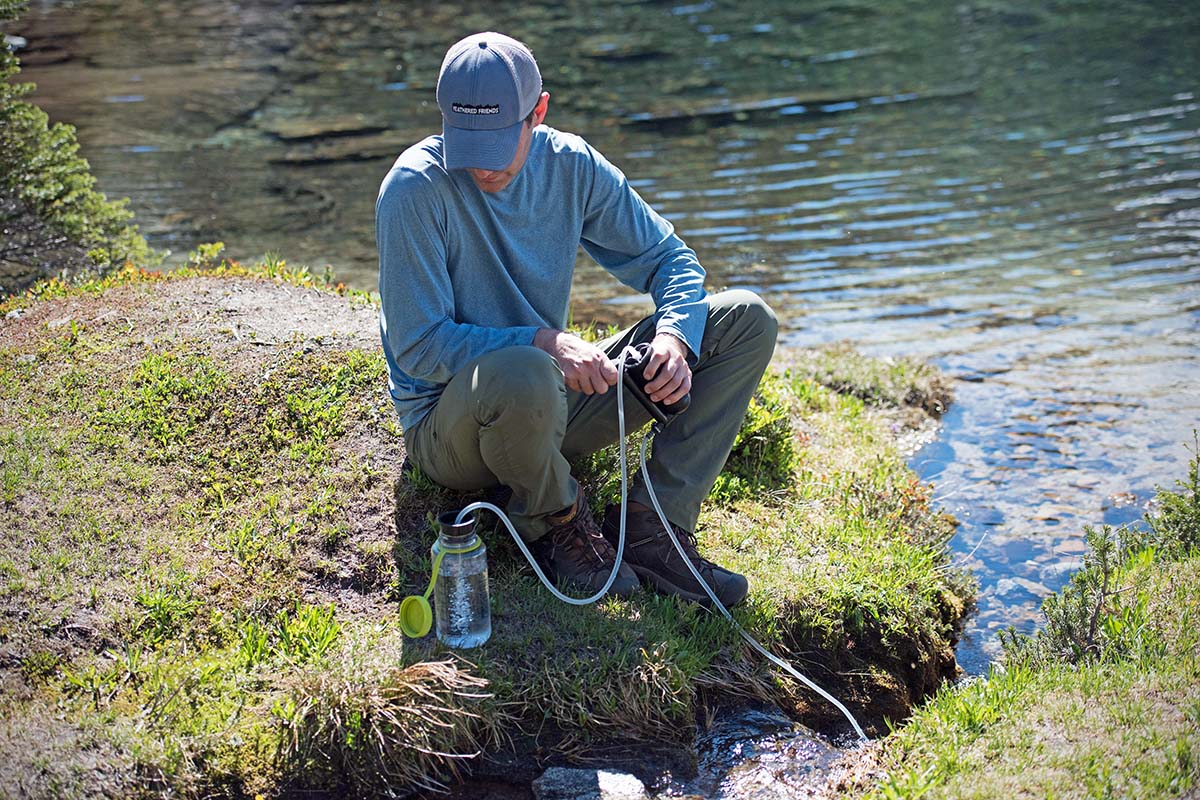
We used to exclusively use pump filters, but the rise in popularity of gravity and other in-line filters (straw filters, bottle filters) has largely rendered them obsolete. The largest downside to pump filters and purifiers is the time and effort that manually operating the pump requires. In general, they also require more maintenance than other types of water filters and are more expensive than bottle or straw filters (see below). Additionally, pump filters and purifiers tend to be on the heavier end of the spectrum (again, there are exceptions like the 5-ounce MSR TrailShot).
Bottle filters and purifiers attach directly to the mouth of your water bottle and filter as you drink. These are extremely convenient for day trips, trail runs, mountain bike rides, or even extended backpacking outings where you know you will continually come across water sources. You can fill up your bottle, drink it dry, and repeat at the next stream. Bottle filters generally are lightweight, packable, and often come with the bottle itself (so you get filter and water receptacle all in one). Like the Katadyn BeFree, most setups of this style filter rather than purify the water, with the exception of the Grayl Ultralight Water Purifier Bottle, which also protects against viruses.
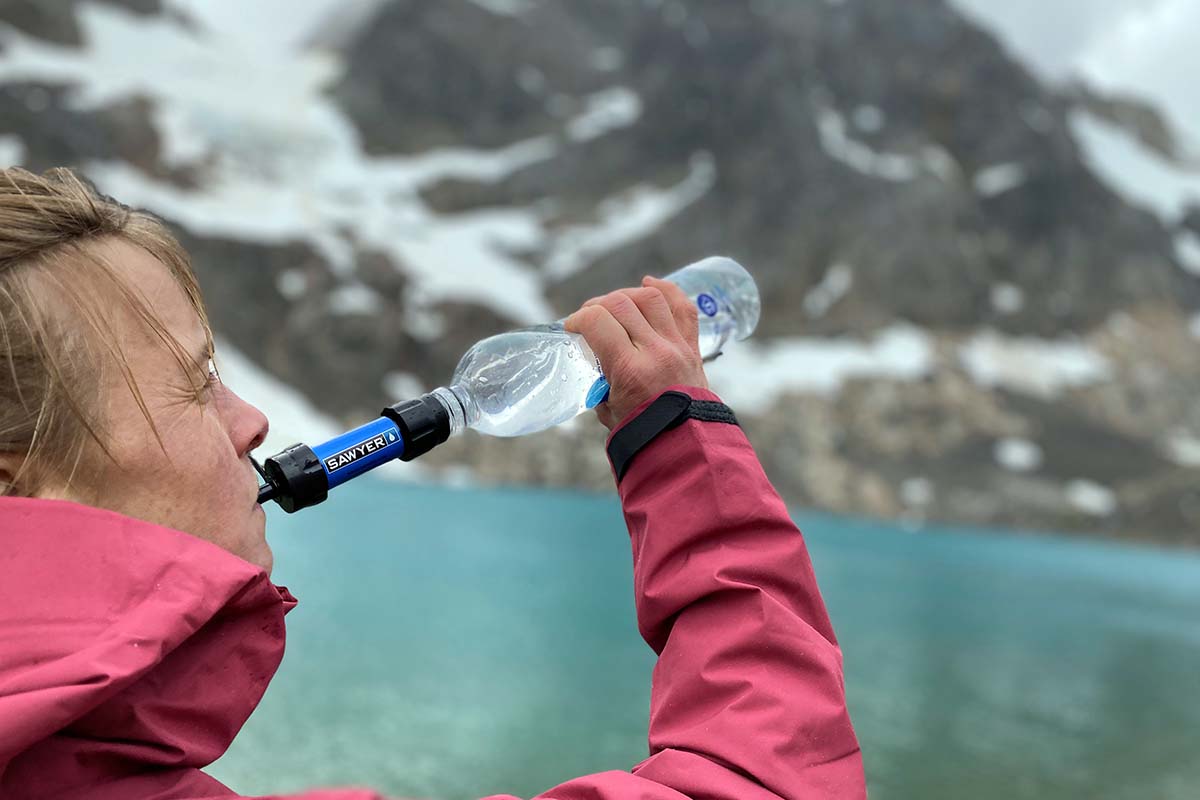
The drawbacks to bottle filters and purifiers is that they are slow and only clean small amounts of water at a time. While day hiking in Patagonia, we had an experience with the Sawyer Mini (granted, one of the slowest bottle filters) where it was so effortful to drink that we went thirsty on the trail. Further, you get the water in your bottle, and that’s it—no storing larger capacities for future use. As a result, bottle filters are not great for group use or cooking in camp (we prefer the efficiency and effectiveness of gravity and pump filters instead). But for ultralighters and those on shorter day trips, a bottle filter is a great option.
Straw filters are even easier to pack than bottle filters—they are a simple tube with a filter inside that allows you to drink directly from a water source. The suction from your mouth pulls water through the filter, cleaning it as it goes. The LifeStraw is perhaps the best-known straw filter and a true archetype of the category. Straw filters are great for day hikers, trail runners, or mountain bikers, and should be relied on only in areas that have ample reliable water sources. Because they are so small and packable—not to mention inexpensive—straw filters are also often brought along on extended trips as a backup to a more efficient, higher-capacity filtration system.
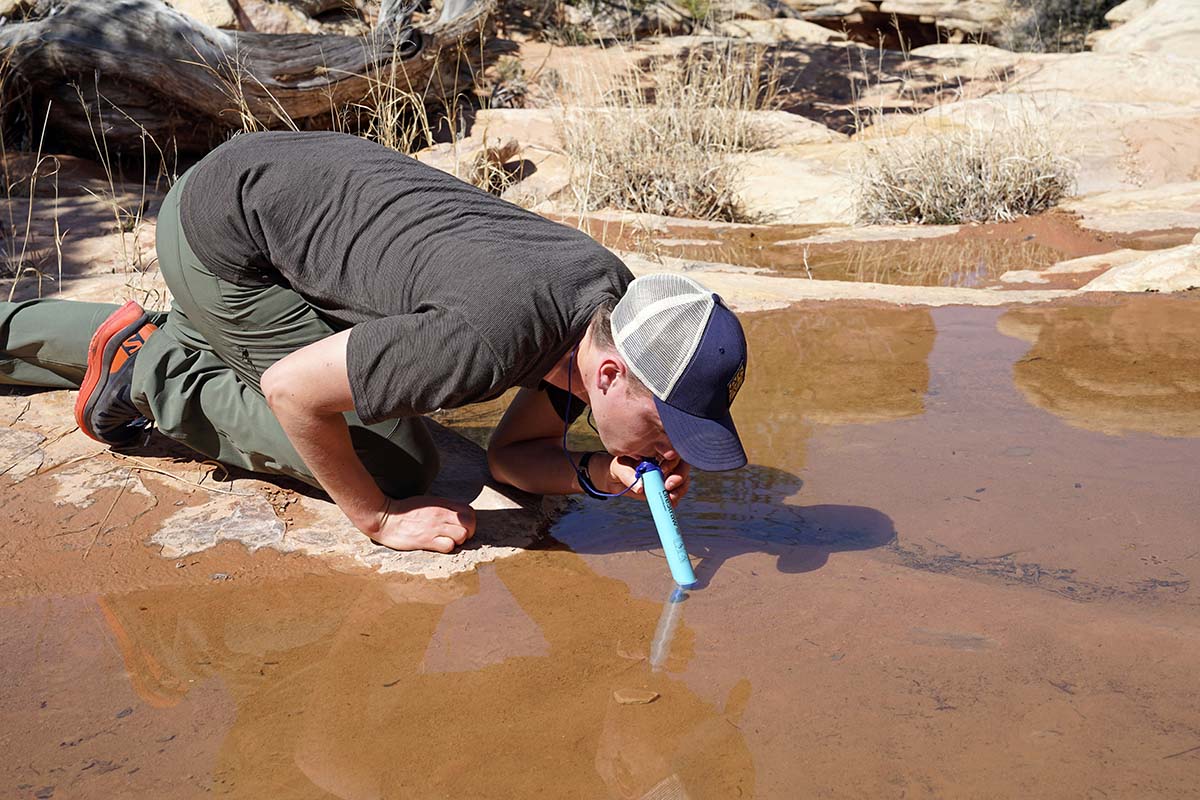
However, there are many downsides to straw filters. Most obviously, they do not offer water storage, making them less than ideal for areas with only intermittent sources. Further, to operate a straw filter, you have to get down to water level, which often means lying on the ground. And finally, we’ve found that it’s necessary to apply a great deal of force to suck water through a straw filter, which means a lot of effort for very little reward. In our experience, these factors have made us less inclined to drink, and thus more likely to become dehydrated.
If you’ve been around the outdoor world for awhile, you’ll recognize chemical purifiers (read: iodine) as a classic method of obtaining clean drinking water in the backcountry. Nowadays, chemical purifiers come in the form of small tablets or drops that you add to water and wait the instructed amount of time for activation—usually around 20 to 30 minutes (and up to four hours to protect against Cryptosporidium). A huge upside to chemical purifiers is that they are packable and inexpensive: Aquamira Water Treatment weighs only 3 ounces, will purify 30 gallons of water, and costs just $15. Because they are so unobtrusive, many hikers keep chemical purifiers in their pack at all times in case of emergency. Additionally, you get virus protection, which is a must for traveling to overpopulated wilderness areas or less-developed regions.
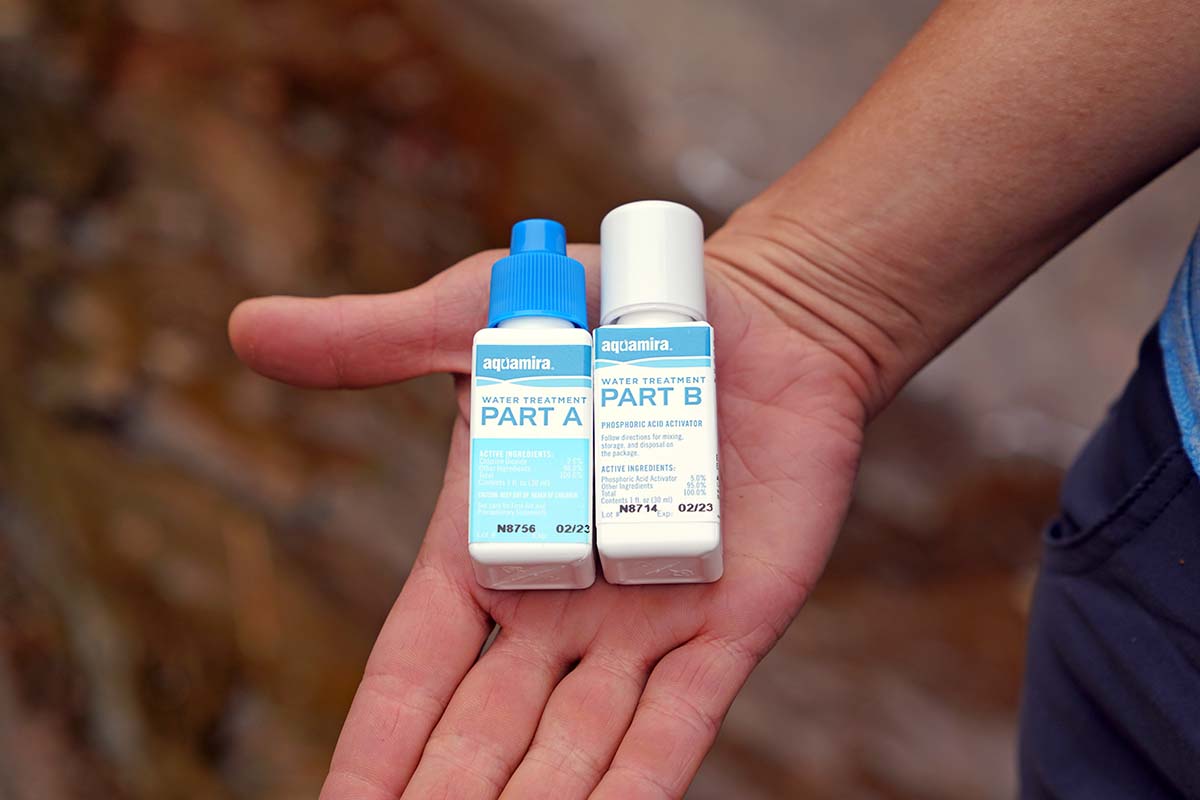
However, although chemical purifiers fully treat the water, they do not filter it. This means that unless you pre-filter your water, any dirt, twigs, or debris will also be in what you drink. Thus, chemical purifiers are best when the water source is a quickly moving stream or glacial lake, but not ideal for stagnant, muddy puddles. Another drawback is that some chemical purifiers can result in bad-tasting water, although this can easily be remedied with drink mix or electrolyte tabs.
A final method for purifying water is through the use of ultraviolet rays. SteriPen makes the majority of popular UV purifiers, such as their UltraLight UV. To purify water with UV, you simply insert the SteriPen into a liter of water and let it sit for about 90 seconds. In the end, this is much quicker than a chemical purifier (which can take 30 minutes), but requires slightly more hands-on time.
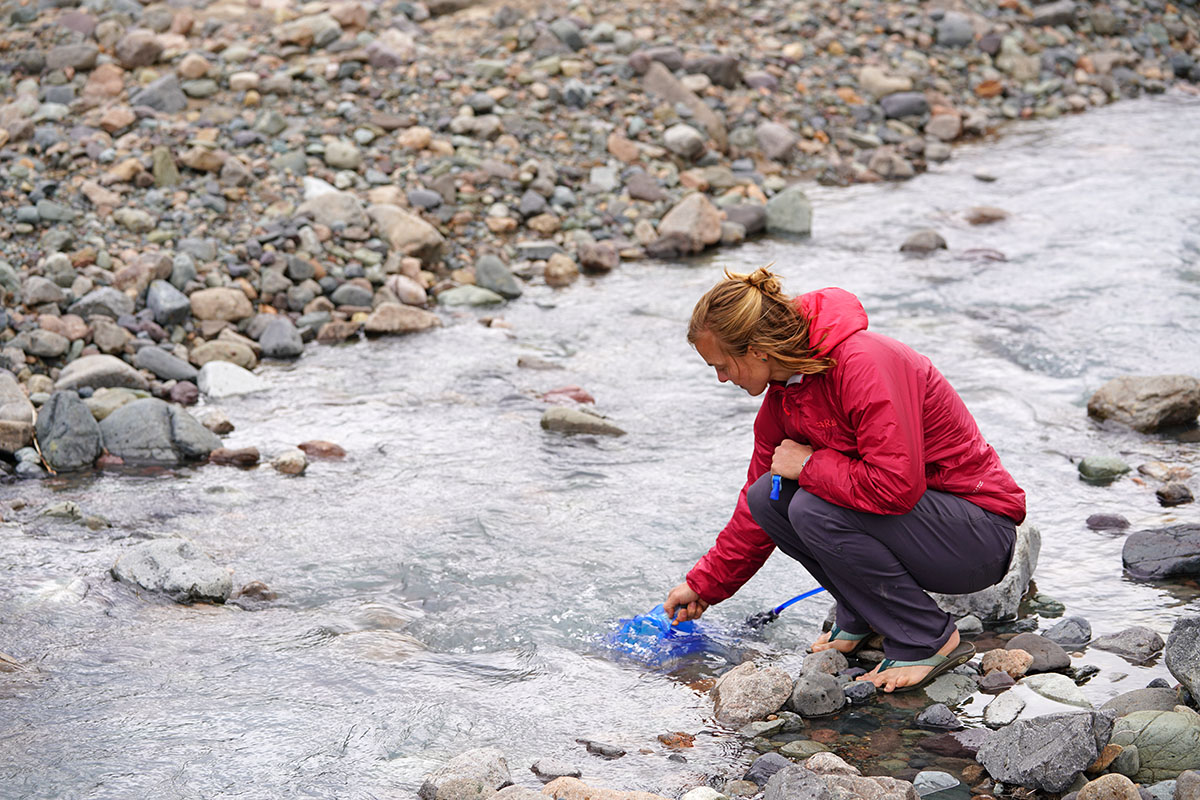
Like chemical purifiers, UV purifiers do not include a filter, which means you’ll want to pre-filter your water or drink from a swift-moving or clear source. Further, because you can generally purify only one liter at a time, UV filters are not great for large groups. They also require batteries and complex technology that can be impossible to fix in the field, so it’s a good idea to bring a backup, like the aforementioned iodine tablets.
If you’ve done any research on water filters, you’ve probably seen the term “inline filter” used to describe various models. Put simply, an inline filter is any filter that attaches the supply of dirty water to the final destination (e.g., a clean reservoir or your mouth), usually by way of a tube or straw. For example, the MSR Thru-Link Inline attaches directly to a hydration reservoir on one end and to the hose on the other. As you suck, water travels from the dirty supply, through the filter, and into your mouth. Many filters used in gravity, straw, and bottle systems are inline filters that have a primary use (e.g., the Sawyer Squeeze is primarily a bottle filter) but can be adapted for inline use (i.e. as part of a gravity system) with additional tubing or reservoirs. As such, inline filters are the most versatile in their class and one of the most popular styles today.
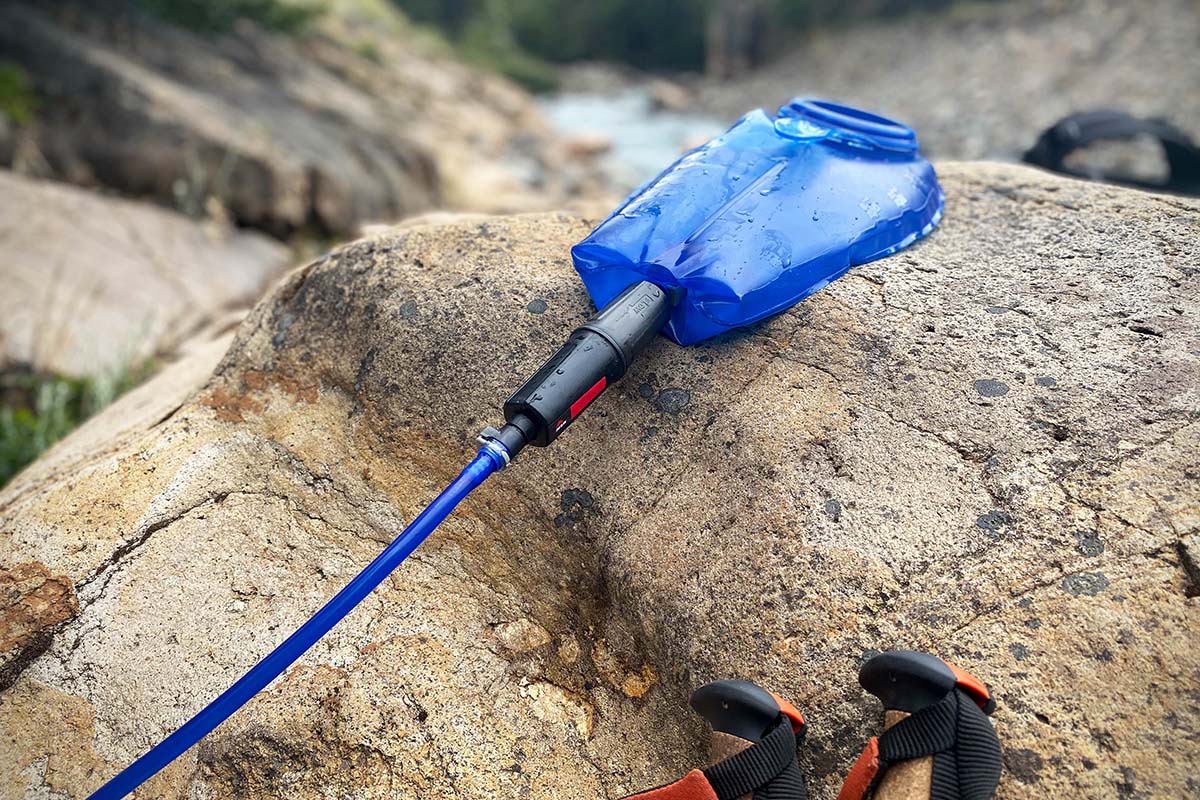
Not all water is created equal. If your water source is a clear, fast-flowing glacial-melt stream, chances are you won’t need to pre-filter, even if you are using a chemical or UV purifier. However, perhaps your only option for a water source is the sediment-heavy Colorado River (which clogged our Katadyn Gravity BeFree in a matter of minutes), or a shallow pond full of floaties. If this is the case, we recommend pre-filtering your water, regardless of whether you plan on using a filter or purifier to treat it.
Pre-filtering is best done by pouring the untreated water through a bandana or piece of clothing and into a clean receptacle before treatment. In the case of high-sediment water (picture a chalky river flowing from a glacier), you’ll want to let it sit for a number of hours in a receptacle (such as a Ziploc bag or bigger vessel like the Sea to Summit Folding Bucket) and then skim the clear water off of the top for treatment. For less-than-clear water sources, the benefits to pre-filtering are obvious: it helps to prevent clogging and increase the lifespan of filters, and—in the case of chemical or UV purifiers—will improve the water’s taste and keep you from dodging floaties as you drink.
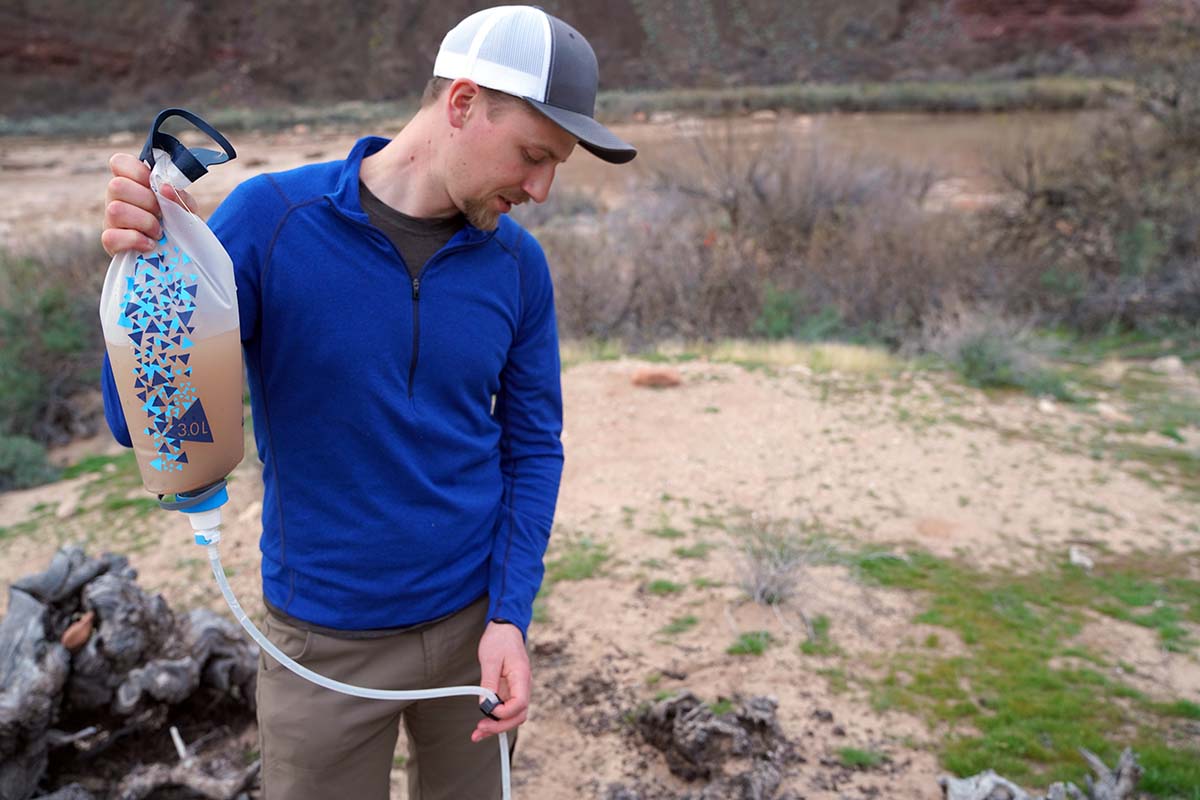
With all backpacking gear, weight and packability are critical considerations—the more space and weight something takes up in your pack, the more of a hassle it will be day after day on the trail. However, as with most items, bigger and bulkier water filters and purifiers tend to be more efficient, offer higher performance, and serve more people. That said, each backcountry enthusiast will have different priorities, and weight and packability will be just one of many considerations.
The lightest and smallest forms of water treatment are chemical droplets or tablets, which weigh around 3 ounces or less and take up virtually no space in your pack (even if they’re not your primary treatment method, we recommend always having a few as a backup). Then there are ultralight filters (like the 2-ounce Sawyer Mini or 2.3-ounce Katadyn BeFree), which take up a bit more space than chemical purifiers and are generally only ideal for one person but treat water on the spot (no need to wait 30 minutes). On the far end of the spectrum are gravity and hand pumps that can have multiple reservoirs and hoses in addition to the filter, such as the 1-pound MSR Trail Base Gravity Filter System 2L. While these systems have increased weight and bulk, they offer great flow rates and easy filtration for basecamp and large-group use. In the end, you’ll have to weigh the various factors—speed, efficiency, volume, etc.—to determine how much you want to prioritize a streamlined load.
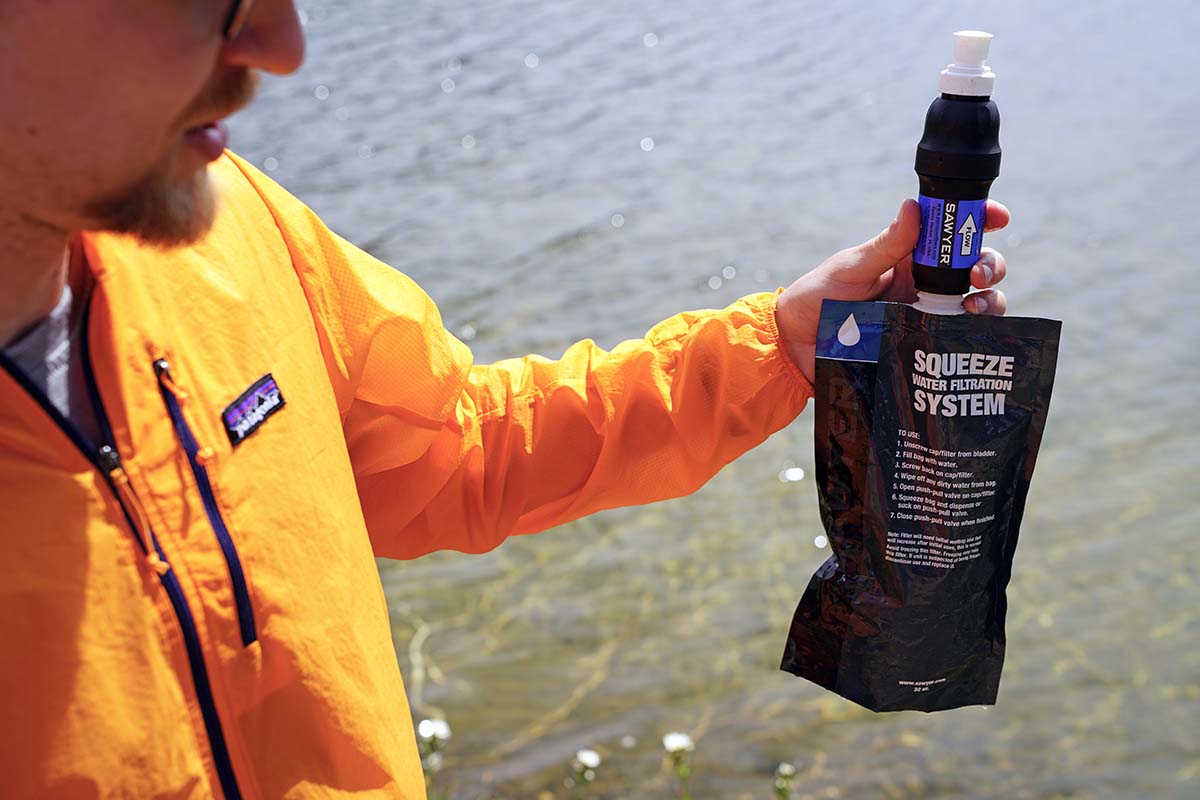
Flow rate refers to how fast water will flow through the filter, measured in liters per minute. In our opinion, the speed of filtering is worth considering because you are more likely to keep yourself hydrated if you have relatively quick access to clean water. It is also nice to have a fast flow rate if you are traveling quickly (in the case of thru-hikers and trail runners) or are limited on water sources and need to stock up from a single source.
Most water filters have a flow rate of around 1 liter per minute, with models like the MSR Guardian Purifier touting impressive rates of about 2.5 liters per minute. As a note, the flow rate spec provided by manufacturers is often idealistic and in practice will likely be slower than stated—especially as your filter ages and the pores become more clogged with sediment. Further, regular filter maintenance will increase the flow rate (we break this down further in the "Maintenance" section below). And although flow rate doesn’t apply to chemical purifiers, it is also important to note how long these take to do their job. You’ll typically need to wait around 20 to 30 minutes for most chemical purifiers, and about a minute and a half for UV purifiers.
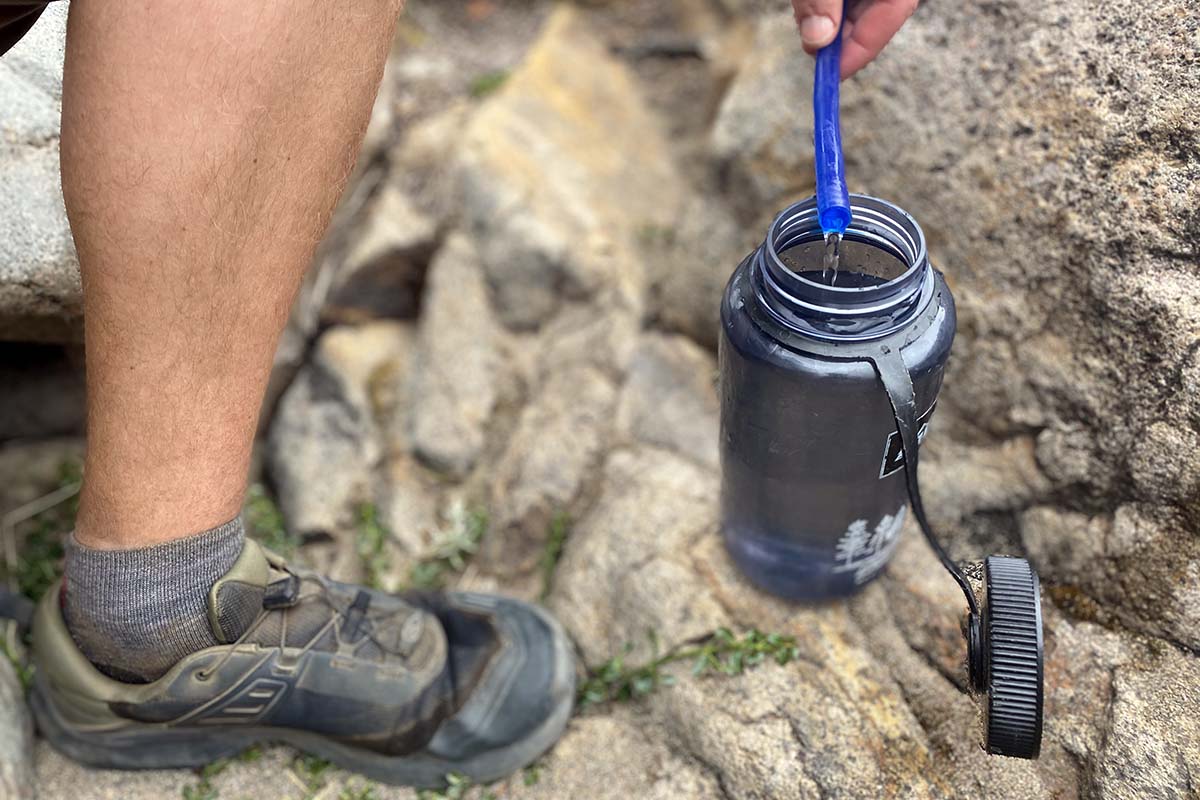
Unless you opt for a straw filter, you’ll be using a water bottle or reservoir in tandem with your water filter. To make things easy, most filters have a simple hose or cap that fits onto commonly sized bottle openings. The MSR MiniWorks, for example, attaches seamlessly to a wide-mouthed Nalgene water bottle, while the Sawyer Squeeze and Mini can screw onto standard-sized disposable plastic water bottles (favored by ultralight enthusiasts and thru-hikers). Several water filters are compatible with hydration reservoirs as well—in our testing of the MSR Thru-Link Inline Water Filter, it snapped directly onto our CamelBak and Platypus reservoirs, pulling water through the filter as we drank. In the end, it helps to consider what style of water storage you favor and match it with your filter accordingly (or vice versa).
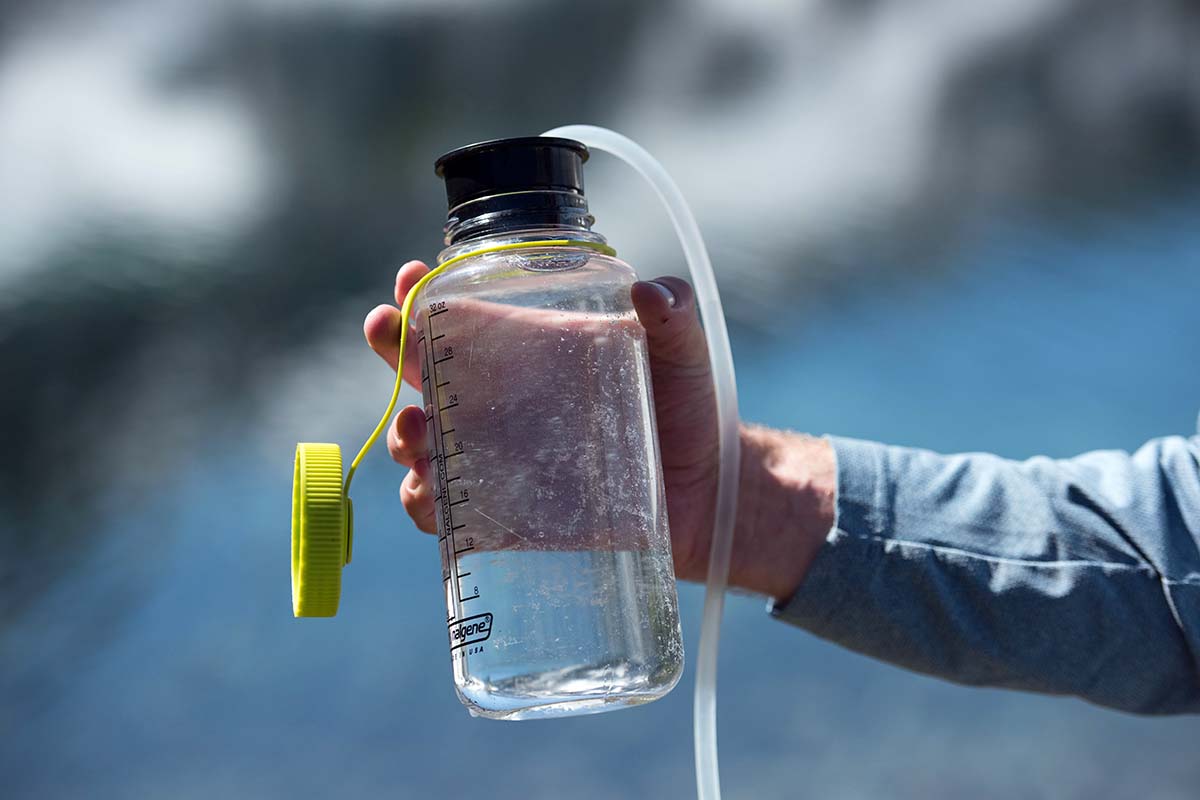
Sediment buildup is unfortunately inevitable over time. When small particles get lodged in your filter, flow rates will slow and (unless cleaned regularly) permanent damage can occur. Because of this, you will want to regularly clean your water filter to maximize performance and longevity. Maintenance will vary from filter to filter, but the simplest models are cleaned by backflushing treated water through the filter (with the LifeStraw, you blow through the opposite end after each use). Hand pumps tend to have a more involved cleaning process, requiring you to take apart the filter apparatus and brush it down (check your user’s manual before diving in). And if regular maintenance isn’t your cup of tea, consider chemical purifiers.
Even with regular maintenance, water filters can only treat so many liters throughout their lifespan and will need to be replaced eventually (with the exception the Sawyer Squeeze, which boasts a lifetime warranty). In general, this lifespan is measured in liters—the MSR Guardian is at the upper end of the spectrum at a 10,000-liter lifespan, whereas the Katadyn Hiker has a lifespan of 750 liters. This is a sizable difference in filter life, but so is the difference in price at $350 and $70 respectively. For a casual camper getting out a handful of times of year, 750 liters will be more than sufficient for many seasons.
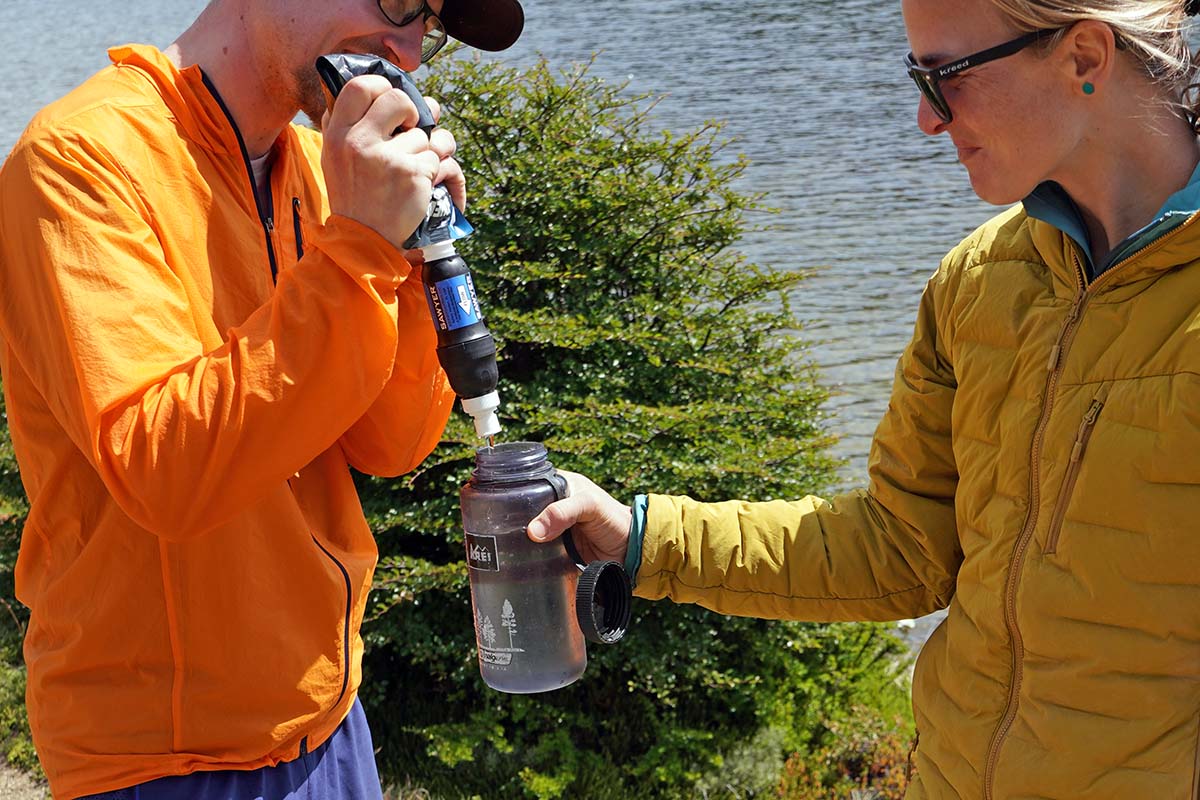
Much like flow rate (or any other manufacturer-provided spec for that matter), the stated lifespan may be a bit ambitious. If your filter is constantly clogging despite cleanings, it might be time to consider a replacement. The good news is that most manufacturers sell replacement filter cartridges, so you will be able to revive your filter without having to purchase an entirely new system.
As referenced a few times above, it's always a good idea to bring a backup filtration system with you into the backcountry. Many backpacking water filters have plastic components that can break or malfunction, and you certainly don't want to risk drinking contaminated water. A LifeStraw is a good option for backup filtration as it costs only $20 and is quite light and sleek, easily fitting into the corner of a pack. But in our opinion, the ideal option for a backup is a chemical purifier, which is inexpensive, weighs just a few ounces, and will allow you to purify water that can be stored in a receptacle. For this reason, most veteran backpackers always keep a few chemical purification tabs in their pack in case of emergency.
Boiling water is one of the oldest forms of water purification, and it’s still a viable method for treating water in a pinch. While we’d seldom boil water as our primary means of purification (snow melt is an exception), it’s a valuable tool to have in your arsenal should the need arise. However, this method can be very labor-intensive and time-consuming, especially if you only have a small pot that can boil one liter at a time, and will blow through a lot of fuel in the process. If you do choose to purify water in this way, opinions vary on how long it needs to boil—the EPA recommends at least one minute of a rolling boil and up to three minutes at higher elevations.
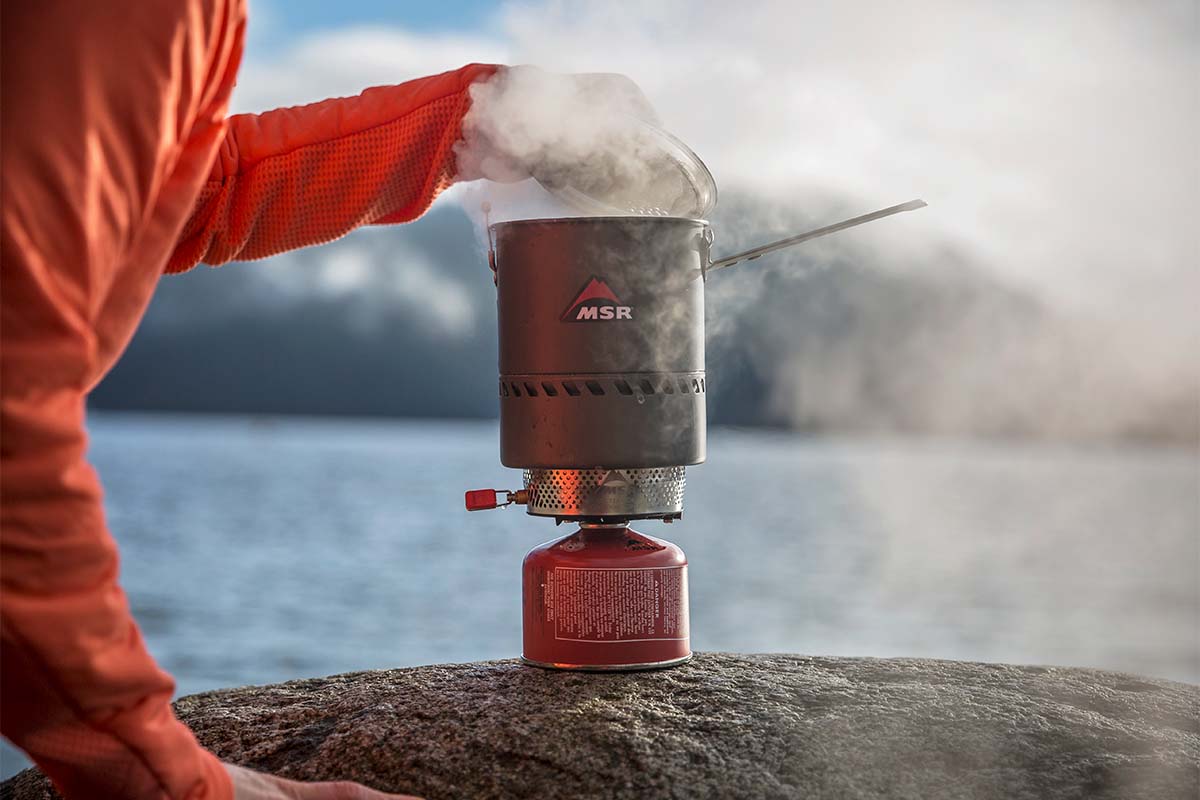
With years of experience under our belts, we’ve had ample opportunities to test the various water treatment methods in real-life scenarios, from large-group adventures to trail running and winter camping. We cover all of our top picks in our article on the best backpacking water filters and purifiers, but below are some of our favorites broken down by category:
Best Gravity Water Filter for Groups: Platypus GravityWorks 4L
Best Ultralight Water Filter: Sawyer Squeeze Water Filter
Best Purifier for Dirty Water: MSR Guardian Purifier System
Best Chemical Water Treatment for Backpacking: Katadyn Micropur MP1
Best Bottle Filter for Trail Running: Katadyn BeFree Collapsible Bottle 1L
Best Inline Filter for a Hydration Reservoir: MSR Thru-Link Inline Water Filter
See Our Top Water Filter and Purifier Picks